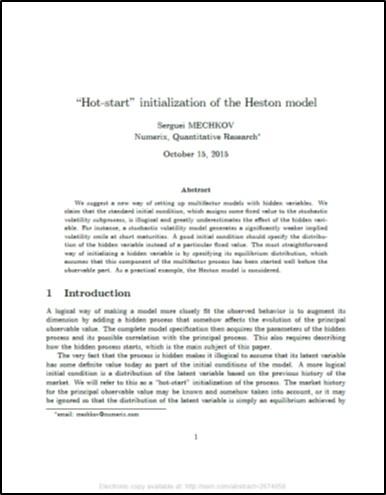
"Hot-start" Initialization of the Heston Model
We suggest a new way of setting up multifactor models with hidden variables. We claim that the standard initial condition, which assigns some fixed value to the stochastic volatility subprocess, is illogical and greatly underestimates the effect of the hidden variable. For instance, a stochastic volatility model generates a significantly weaker implied volatility smile at short maturities. A good initial condition should specify the distribution of the hidden variable instead of a particular fixed value. The most straightforward way of initializing a hidden variable is by specifying its equilibrium distribution, which assumes that this component of the multifactor process has been started well before the observable part. As a practical example, the Heston model is considered.
Author: Dr. Serguei Mechkov, Senior VP of Quantitative Research, Quantitative Research, Numerix
We suggest a new way of setting up multifactor models with hidden variables. We claim that the standard initial condition, which assigns some fixed value to the stochastic volatility subprocess, is illogical and greatly underestimates the effect of the hidden variable. For instance, a stochastic volatility model generates a significantly weaker implied volatility smile at short maturities. A good initial condition should specify the distribution of the hidden variable instead of a particular fixed value. The most straightforward way of initializing a hidden variable is by specifying its equilibrium distribution, which assumes that this component of the multifactor process has been started well before the observable part. As a practical example, the Heston model is considered.
Author: Dr. Serguei Mechkov, Senior VP of Quantitative Research, Quantitative Research, Numerix


